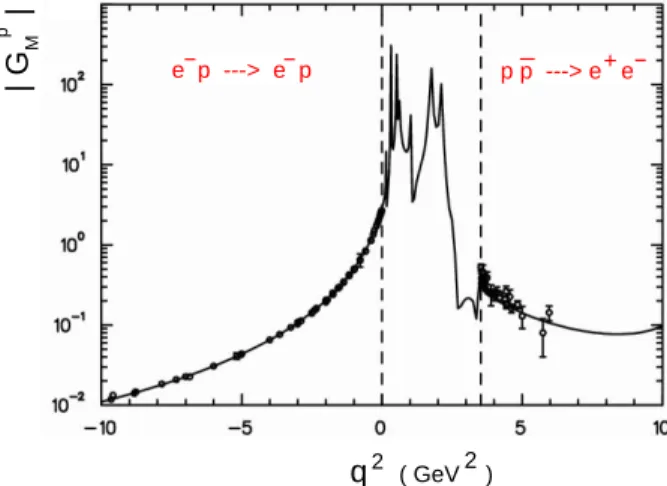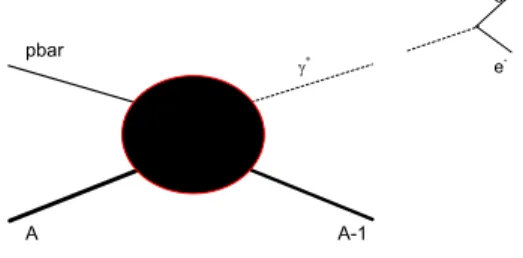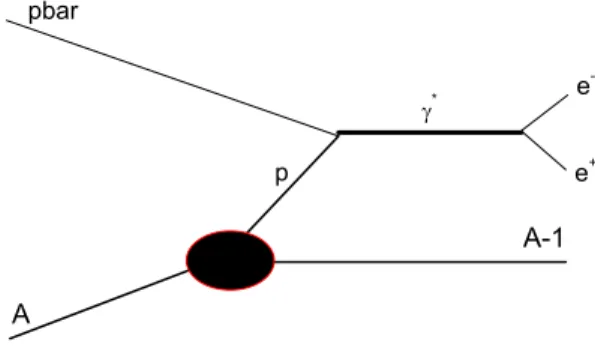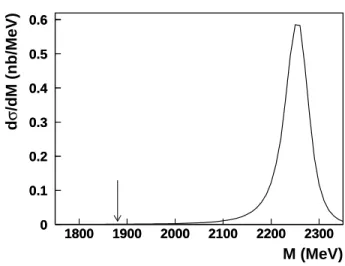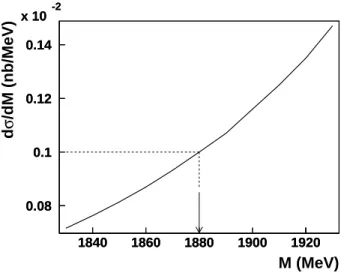arXiv:1010.2872v1 [nucl-th] 14 Oct 2010
Proton Timelike Form Factors Near Threshold
via Antiproton-Nucleus Electromagnetic
Annihilation
V.A. Karmanov1,H. Fonvieille2 1
Lebedev Physics Institute, Leninsky prospekt 53, 119991 Moscow, Russia 2
LPC, Universit´e Blaise Pascal, IN2P3, 63177 Aubi`ere Cedex, France
Abstract. In the reaction of the antiproton-deuteron electromagnetic annihi-lationp + d → ne¯ +e−
the value of the invariant massMe+e− of thee +e− pair can be near or below thepp mass even for enough high momentum of inci-¯
dent antiproton. This allows to access the proton electromagnetic form factors in the time-like region ofq2
near thepp threshold. We estimate the cross sec-¯
tiondσ(¯p + d → e+
e−
n)/dMe+e−for an antiproton beam momentum of 1.5
GeV/c. We find that for values ofMe+e−near thepp threshold this cross sec-¯
tion is about 1 pb/MeV. The case of heavy nuclei12C,56Fe and197Au is also estimated. Elements of experimental feasibility are studied in the context of thePANDA project [1, 2]. We conclude that this process has a chance to be
measurable atPANDA.
1 Introduction
The electromagnetic form factors of the proton and the neutron are basic ob-servables, which are the goal of extensive measurements. In the spacelike re-gion, i.e.for a virtual photon four-momentum squaredq2< 0, these form factors give information about the spatial distribution of electric charge and magnetiza-tion inside the nucleon. In the timelike region (q2 > 0) they tell us about the dynamics of the nucleon-antinucleon (N ¯N ) interaction.
The theoretical models, generally based on dispersion relations [3–5] or semi-phenomenological approaches [6,7], predict a smooth behavior of the form factor in the measured regions, but a peaked behavior in the timelike region be-low theN ¯N threshold (0 < q2< 4m2,m is the nucleon mass), due to poles in the amplitude (see e.g.fig. 1, taken from [8]). These poles are phenomenological inputs, built from meson exchange, and their properties are fitted to the data in
the measured regions. The corresponding irregularities in form factors are re-lated to the transition ofp¯p to vector mesons which can decay in e+e−pair via a virtual photon.
The mesons with a mass near thep¯p mass can have a quasinuclear nature,
i.e., they can be formed by bound states and resonances in thep¯p system. Such
vector mesons were predicted in the papers [9, 10]. Note that such mesons can be formed not only in thep¯p system but in N ¯N in general and they can have
not only vector quantum numbers. A review on quasinuclear mesons in theN ¯N
system is given in [11]. | G | M p e p ---> e p- - p p ---> e e + ( GeV ) 2 q2
Figure 1. Experimental data and predictions for the magnetic proton form factor in the domain −10 GeV2
≤q2
≤10 GeV2
. The figure is taken from [8].
The under-threshold region (0 < q2 < 4m2) is called unphysical because it cannot be accessed experimentally by an on-shell process. Some experiments have been performed in the vicinity of theN ¯N threshold, either in p¯p → e+e− at LEAR [12] or in the inverse channele+e−
→ p¯p at Babar [13], but they
cannot go below this physical threshold. However, a nucleus provides nucleons with various momenta, in modulus and direction, and also various degrees of off-shellness. Therefore it offers the possibility to produce anN ¯N electromagnetic
annihilation with an invariant mass squaredq2= s ¯
ppsmaller than4m2. This possibility, which may give access to the proton form factors in the underthreshold region, for an off-shell nucleon, was explored in our paper [14]. The present talk is based on this paper.
deuterium [15]. The reaction is then:
¯
p d → e+e−n (1)
(a crossed-channel of deuteron electrodisintegration). The aim of the present paper is to revive this study in view of the future antiproton facility FAIR at GSI.
Other channels can give access to the off-shell nucleon form factors in the timelike region, including the underthreshold region; such processes have been studied theoretically in ref. [16] (γp → pe+e−) and in refs. [17, 18] (¯
pp → π0e+e−
).
This paper is organized as follows: a theoretical study is presented in sect. 2, experimental aspects are discussed in sect. 3 and a conclusion is given in sect. 4.
2 Theoretical study
In elastic electron scattering from the nucleone−
N → e−N the momentum transfer squaredq2 = (k − k′
)2is always negative. This allows to measure the nucleon form factors in the space-like domain ofq2.
On the contrary, in the annihilationN ¯N → γ∗
→ e+e−the mass of virtual photon is equal to the total c.m. N ¯N energy. Its four-momentum squared is
always greater than4m2. This allows to measure the nucleon form factors in the time-like domain ofq2, above theN ¯N threshold. In this reaction, in order to study the form factor behavior in a narrow domain near threshold, where non-trivial structures are predicted [11], one should have a beam of almost stopped antiprotons. This non-easy technical problem was solved at LEAR [12]. How-ever, the under-threshold domain0 ≤ q2≤ 4m2remains kinematically unreach-able in this type of experiments.
e -e + A-1 A pbar
Figure 2. The processpA → (A − 1)γ¯ ∗
(followed byγ∗
→e+
e−
).
One can penetrate in this domain ofq2in thep annihilation on nuclei¯
¯
pA → (A − 1) e+e−
see fig. 2. The symbol(A − 1) means not necessarily a nucleus but any system with the baryon numberA − 1. Since extra energy of the antiproton can be ab-sorbed by the(A − 1) system, the e+e−
pair may be emitted with very small invariant mass. Therefore the two-body reactionpA → (A − 1)γ¯ ∗is kinemat-ically allowed for a very wide domain of invariant mass of theγ∗
, which starts with two times the electron mass, namely:
4m2e≤ q2≤ (√spA¯ − MA−1)2.
One can achieve near-threshold, under-threshold and even deep-under-threshold values ofq2 even for fast antiprotons. This however does not mean that this reaction provides us direct information about the nucleon form factors. For the latter, we should be sure that the observede+e− pair (and nothing more) was created in the annihilationpp → e¯ +e−
on the proton in the nucleus, i.e., that the reaction mechanism is given by the diagram of fig. 3 or by a similar diagram where thep can rescatter before annihilation.¯
* p pbar e + e -A-1 A
Figure 3. Amplitude of the reactionpA → (A − 1)γ¯ ∗
in impulse approximation. At the same time, since the nucleons in the nucleus are off-mass-shell, the form factors entering the amplitude of fig. 3, are not precisely the same as found in the freepp annihilation. In general, the three-leg vertex F = F (p¯ 2
1, p22, q2) depends not only on the photon virtualityq2, but also on the nucleon onesp2
1, p22. In the case considered, the incident antiproton is on-energy-shell: p2
¯ p = m2, however the form factors depend on the proton virtualityp2
p. How the form factor
F (p2 ¯
p = m2, p2p 6= m2, q2) vs.q2 differs from the free oneF (p2p¯ = m2, p2p =
m2, q2) – this depends on the dynamics determining its behavior vs.the nucleon leg virtuality. The nucleon form factors with off-shell nucleons were studied in the papers [19, 20]. Generally, we can expect that the form factor dependence vs.p2
determined by the nucleon self-energy corrections (i.e., by the structure of the nucleon), whereas theq2dependence in the time-like domain is governed by the
¯
pp interaction. The nucleon dynamics has a much larger energy scale than the
nuclear one. The typical off-shell variation found in the papers [19,20] was from a few to 10 percent. We do not pretend to such an accuracy here. Therefore we neglect this effect in our calculation. We will come to this question later. In any case, both domains:q2 < 4m2, p2
p = m2andq2 < 4m2, p2p< m2are totally unexplored experimentally and are interesting and intriguing.
We emphasize that though the form factor dependence onp2
p can be weak, the nucleon off-mass-shell effect is very important for the kinematical possibil-ity to reach the near- and under-threshold domain ofq2 with fast antiprotons. To produce the near-thresholde+e− pairs in annihilation of a fastp on an on-¯ mass-shell proton, the antiproton should meet in the nucleus a fast proton with parallel momentum. The probability of that, which was estimated in the Glauber approach, is negligibly small relative to the results presented below. However, if the effective massp2
pof the virtual proton is smaller thanm2(that is just the case in a nucleus), then the near- and under-thresholde+e−
pairs can be produced in collisions with not so fast intra-nucleus nucleons. This effect considerably in-creases the cross section. To have an idea of the order of magnitude which one can expect for this cross section, we will calculate it in the impulse approxi-mation. Numerical applications will be done for the lowest antiproton beam momentum foreseen in future projects. Namely, at the High Energy Storage Ring at FAIR-GSI this value is 1.5 GeV/c.
2.1 Cross section calculation
At first, we consider the case of the deuteron target. If we know the amplitude of the reactionpd → e¯ +e−
n: Mpd→e¯ +e−n (to be calculated below), then the
corresponding cross section is given by:
dσpd→e¯ +e− n = (2π)4 4I |Mpd→e¯ +e−n| 2 (2) ×δ(4)(p ¯ p+ pd− pe+− pe−− pn) d3p e+ (2π)32ǫ e+ d3p e− (2π)32ǫ e− d3p n (2π)32ǫ n
whereI results from the flux factors. Here and below we imply the sum over the
final spin projections and average over the initial ones.
Our estimations are carried out in the impulse approximation, when the mechanism is given by the diagram of fig. 3. Then the total amplitude squared
and to the square of the deuteron wave function|ψ|2:
|Mpd→e¯ +e−n|2= 4m |Mpp→e¯ +e−|2|ψ|2, (3)
and|ψ|2is normalized to 1.
We are interested in the distribution in the invariant massM of the final
e+e−system. To find it, for fixed value of
M, we can integrate, in some limits,
over the angles of the recoil neutron (determining the neutron recoil momentum) and over the angles of the emittede+e−
in their center of mass. This can be done using standard phase volume techniques. The derivation is presented in detail in [14]. The final result reads:
dσpd→e¯ +e−n
dM = σpp→e¯ +e−(M) η(M), (4)
whereη(M) is the distribution (given by eq. (6) below) of the e+e−
invariant massM and σpp→e¯ +e−(M) is the cross section of the ¯pp → e+e
−
annihilation at the total energyM.
The calculation ofσpp→e¯ +e−is standard. To estimate the nuclear effect, we
omit the nucleon electromagnetic form factors. Then the pp → e¯ +e− cross section obtains the form:
σpp→e¯ +e− = 2α2π(2m2+ M2) 3M2mp ¯ p,lab . (5)
Thoughσpp→e¯ +e− depends onM, the main (nuclear) effect is determined
by the factorη(M) [14]: η(M) = mp ∗ γ∗ nM (2π)2√s ¯ pd Z 1 −1|ψ(k)| 2dz. (6)
Herez = cos θ, where θ is the angle, in the c.m. frame of the reaction, between
the initial deuteron momentum~p∗
d and the final neutron momentum~p ∗ n. The argument of the wave functionk depends on z. This explicit dependence is
given in [14].
Since, as mentioned, the wave function squared|ψ(k)|2is normalized to 1, the distributionη(M) is also automatically normalized to 1:
Z ∞
0 η(M)dM = 1.
(7) The total cross section is obtained by integrating (4) in the finite limits
Mmin ≤ M ≤ Mmax, where Mmin = 2me, Mmax = √spd¯ − m. Ne-glecting the electron mass, we can putMmin = 0. For pp,lab¯ = 1.5 GeV/c the
valueMmaxis high enough and provides the normalization condition (7) with very high accuracy.
To emphasize more distinctly the effect of the nuclear target, we can rep-resent the cross section (5) of the annihilationpp → e¯ +e− on a free proton similarly to eq. (4):
dσpp→e¯ +e−
dM = σpp→e¯ +e−δ(M − √s
p¯p) (8)
whereσpp→e¯ +e− is defined in (5),sp¯p = (pp+ pp¯)2. The fact that in the
anni-hilation on a free proton the mass of the finale+e− pair is fixed is reflected in (8) in the presence of the delta-function. Comparing this formula with (4), we see that the effect of the nuclear target results in a dilation of the infinitely sharp distributionδ(M −√spp¯) in a distribution of finite width η(M). The dilation of a distribution does not change its normalization:η(M) remains normalized to 1.
2.2 Analysis and numerical calculations
At first glance, the small near-thresholdpp c.m. energy M ≈ 2m in the collision¯
of a fastp (p¯ p¯ = 1500 MeV/c) is achieved, when the antiproton meets in the deuteron a fast proton having the same momentum as thep, in modulus and¯
direction. The protons with such a high momentum are very seldom in deuteron. For this mechanism, the cross section would be very small. However, the near-threshold value ofM is obtained in other kinematics. As we mentioned, the proton momentak in the deuteron wave function ψ(k) in eq. (6) start with k ≈ kmin ≈ 360 MeV/c only (that corresponds to z ≈ 1). The main reason which allows to obtain in this collision the valueM ≈ 2m is the off-shellness of the proton:m∗
≤ 0.85m instead of m∗
= m. This 15% decrease relative to
the free proton mass is enough to obtain the invariantp¯p mass M ≈ 2m, when
one has the two parallel momenta: 1500 MeV/c forp and 360 MeV/c for p.¯
The cross section dσpd→e¯ +e−
n/dM, eq. (4), has been calculated for an antiproton of momentumpp¯= 1500 MeV/c on a deuteron nucleus at rest, with the deuteron wave function [21], incorporating two components corresponding to S- and D-waves. The result is shown in fig. 4. The maximum of the cross section is atM = 2257 MeV, that corresponds to the ¯p interacting with a proton
at rest (and on-shell). The cross section integrated overM is equal to 43 nb. We remind that these calculations do not take into account the proton form factor. Its influence will be estimated below. The numerical integral over M of the functionη(M), eq. (6), is ≈ 1, in accordance with the normalization condition (7).
0 0.1 0.2 0.3 0.4 0.5 0.6 1800 1900 2000 2100 2200 2300 M (MeV) d σ /dM (nb/MeV) 0 0.1 0.2 0.3 0.4 0.5 0.6 1800 1900 2000 2100 2200 2300
Figure 4. The cross section dσ ¯ pd→e+e− n dM of the reactionpd → e¯ +e− n vs.M, in the
interval:1750 M eV ≤ M ≤ 2350 M eV , calculated for a pointlike proton. The arrow
indicates thep¯p threshold.
The p¯p threshold value M = 1880 MeV is on the tail of the distribution,
far from the maximum. Relative to the maximum, the cross section at threshold decreases approximately by a factor 600. The numerical value at the threshold is: dσ dM M=2m = 1 pb M eV . (9)
In fig. 5 this cross section is shown in the near-threshold interval1830 M eV ≤
M ≤ 1930 MeV . The integral over M in a bin of width 100 MeV centered on
the threshold is:
Z 1930 MeV
1830 MeV
dσpd→e¯ +e−n
dM dM ≈ 100 pb .
These estimations take into account the suppression resulting from the mo-mentum distribution in deuteron. However, they do not incorporate the form factors of the nucleon. To incorporate them in a simplified way, one can con-sider an effective form factor|F | which depends on M, and include it in the integral:
σpd→e¯ +e−n =
Z
σpp→e¯ +e−(M) η(M) |F (M)|2dM (10)
whereσpp→e¯ +e−(M) is the cross section for pointlike nucleons given in eq.(5).
0.08 0.1 0.12 0.14 x 10-2 1840 1860 1880 1900 1920 M (MeV) d σ /dM (nb/MeV) 0.08 0.1 0.12 0.14 x 10-2 1840 1860 1880 1900 1920
Figure 5. The same as in fig. 4, but near thep¯p threshold, in the interval 1830 M eV ≤ M ≤1930 M eV .
factor measured in ref. [13]. By doing this, we neglect all off-shell effects. We interpolate|F (M)| linearly between the measured values, and we limit the inte-gral to the regionM ≥ 2m. In this way we obtain σpd→e¯ +e−
n≃ 1 nb, which is comparable to the total cross sectionσpp→e¯ +e− on a free proton atM = 2257
MeV. We point out that at threshold, our differential cross sectiondσpd→ne+e−¯ of 1 pb/MeV (eq.(9)) is not suppressed by any factor, since there the form factor
|F | seems to be close to 1 experimentally [22,23]. Below this threshold one may
expect a form factor effect larger than one. 2.3 Annihilation on heavier nuclei
ForA > 2, we should take into account the possibility of excitation and breakup
of the final nucleusA − 1 in the process ¯pA → (A − 1)γ∗. The result con-tains the sum over the final energies of the residual nucleus and the integral over a continuous spectrum. That is, the function|ψ(k)|2 in eq. (6) is replaced by the integralREmax
Emin S(E, k)dE, where S(E, k) is the nucleus spectral function
giving the probability to find in the final state the nucleon with the relative mo-mentumk and the residual nucleus with energy E. For high incident energy we
can replace the upper limit by infinity. Then we obtain:
Z ∞
Emin
wheren(k) is the momentum distribution in the nucleus.
To estimate the cross section on heavy nuclei, we will still use eqs. (4), (6) but with the two following changes. (i) We replace the deuteron momentum distribution by the nuclear one. (ii) We multiply (6) by the number of protonsZ.
The numerical calculations were carried out for the12C,56Fe and197Au nu-clei with the nuclear momentum distributions found in the papers by A.N. Anto-nov et al.: [24, 25]. Near threshold, i.e.atM = 1880 MeV, for all three nuclei we obtain very close results given by (compare with eq. (9) for deuteron):
dσpA→e¯ +e−X
dM ≈ 6.5 Z pb
M eV (11)
Multiplying by the chargeZ (Z(12C) = 6, Z(56Fe) = 26, Z(197Au) = 79) and integrating (11) over a 1 MeV interval nearM = 1880 MeV, we get:
σ(12C) = 39 pb, σ(56Fe) = 0.17 nb, σ(197Au) = 0.5 nb.
These results were obtained without taking into account the absorption ofp¯
in nucleus before electromagnetic annihilation. This absorption was estimated in Glauber approach. It reduces these cross sections by only a factor 2.
2.4 Beyond the impulse approximation
There exist other possible mechanisms for the processp d → e¯ +e−n. One of them is the initial state interaction, which includes rescattering (not only elastic) of the initialp in the target nucleus. In the rescattering, the incident ¯¯ p looses
energy and therefore the proton momentum needed to form the invariant mass
M ≈ 2m becomes smaller. The probability to find such a proton in deuteron is
higher. Therefore initial state interaction increases the cross section.
Other processes are discussed in [14]. We emphasize that in any case, what-ever the intermediate steps are in process (1), thee+e−
pair of the final state must come necessarily from the baryon-antibaryon electromagnetic annihilation,pp¯
ornn, because there is only one neutron left at the end. It cannot come from¯
another process, even if there are complicated intermediate steps, like rescatter-ing, etc. Therefore thise+e−
pair is a direct and very little distorted probe of the baryon-antibaryon electromagnetic annihilation vertex.
3 Experimental aspects
Experimental aspects have been investigated in detail in [14] in the case of a deuteron target, i.e.for the three-body processp d → e¯ +e−n, in the conditions of
thePANDA project at FAIR-GSI: an antiproton beam momentum of 1.5 GeV/c
and the detection of the lepton pair. The count rate in the near-threshold region ofM is small but not negligible. The main difficulty is to identify the reaction among the hadronic background which is about six orders of magnitude higher. First elements of strategy were presented for this background rejection, based on particle identification, detector hermeticity, and missing mass resolution.
One should also also note that the luminosity in (pA) decreases with the¯
atomic chargeZ of the target nucleus [1], in a way that roughly compensates the
increase of cross section withZ reported in sect. 2.3.
Although the subject would require a much more detailed study, it was con-cluded that this process has a chance to be measurable inPANDA, given the
very good design performances of the detector.
The antiproton momentum 1.5 GeV/c just corresponds to the threshold value of creation of theΛ ¯Λ pair on a free proton. Therefore the virtual creation of the Λ ¯Λ pair in reaction (1) is not suppressed by the nucleon momentum distribution
in deuteron and contributes just in the domain of the peak of fig. 4, that allows one to study theΛ ¯Λ threshold region with good statistics. In the Λ ¯Λ system,
the quasi-nuclear states were predicted in [26] and, similarly to theN ¯N
quasi-nuclear states, they should manifest themselves as irregularities in the cross sec-tion. The contribution of the channelpp → ¯¯ ΛΛ → e+e−
in the total cross sectionpp → e¯ +e− (the latter equals 1 nb, see sect. 2.2 above) was estimated in [27] as 0.1 nb, i.e.10% of the total cross section. Therefore we expect that the structures caused by the channelpp → ¯¯ ΛΛ → e+e−can be observed in process (1) in the region of massM near the Λ¯Λ threshold.
4 Conclusion
We have studied the reactionpA → (A − 1)γ¯ ∗(followed byγ∗
→ e+e−). This process gives access to thepp annihilation ¯¯ pp → γ∗
at invariant masses√spp¯
which are below the physical threshold of2m, due to the proton off-shellness in
the nucleus. In this way a possibility exists to access the proton timelike form factors in the near-threshold and the totally unexplored under-threshold region, whereN ¯N bound states are predicted.
The differential cross sectiondσ/dM has been calculated as a function of the dilepton invariant massM, for an incident antiproton of 1.5 GeV/c momen-tum on a deuteron target (and heavier nuclei). We find that thep¯p threshold
(M = 2m) is reached for a minimal proton momentum kmin=360 MeV/c in the nucleus, and at this point the cross section is about 1 pb/MeV.
be measurable inPANDA, provided the very good design performances of the
detector.
References
[1] The PANDA Collaboration, Physics Performance Report for PANDA: Strong Inter-action Studies with Antiprotons arXiv:0903.3905 [hep-ex].
[2] The PANDA Collaboration, Technical Progress Report for PANDA, (2005) http://www-panda.gsi.de/archive/public/ panda tpr.pdf
[3] R. Baldini, et al., Eur. Phys. J. C 11 (1999) 709–715.
[4] H. W. Hammer, U.-G. Meissner, D. Drechsel, Phys. Lett. B 385 (1996) 343–347. [5] C. Adamuscin, S. Dubnicka, A. Z. Dubnickova, P. Weisenpacher, Prog. Part. Nucl.
Phys. 55 (2005) 228–241.
[6] F. Iachello, Q. Wan, Phys. Rev. C 69 (2004) 055204. [7] R. Bijker, F. Iachello, Phys. Rev. C 69 (2004) 068201. [8] U.-G. Meissner, Nucl. Phys. A 666 (2000) 51–60.
[9] O. D. Dalkarov, K. V. Protasov, Nucl. Phys. A 504 (1989) 845–854. [10] O. D. Dalkarov, K. V. Protasov, Mod. Phys. Lett. A 4 (1989) 1203. [11] I. S. Shapiro, Phys. Rept. 35 (1978) 129–185.
[12] G. Bardin, et al., Nucl. Phys. B 411 (1994) 3–32. [13] B. Aubert, et al., Phys. Rev. D 73 (2006) 012005.
[14] H. Fonvieille and V.A. Karmanov, Eur. Phys. J. A 42 (2009) 287–298. [15] O. D. Dalkarov, V. G. Ksenzov, JETP Lett. 31 (1980) 397-400. [16] M. Schafer, H. C. Donges, U. Mosel, Phys. Lett. B 342 (1995) 13–18.
[17] C. Adamuscin, E. A. Kuraev, E. Tomasi-Gustafsson, F. E. Maas, Phys. Rev. C 75 (2007) 045205.
[18] A. Z. Dubnickova, S. Dubnicka, M. P. Rekalo, Z. Phys. C 70 (1996) 473–482. [19] H. W. L. Naus, J. H. Koch, Phys. Rev. C 36 (1987) 2459–2465.
[20] P. C. Tiemeijer, J. A. Tjon, Phys. Rev. C 42 (1990) 599–609. [21] J. Carbonell, V. A. Karmanov, Nucl. Phys. A 581 (1995) 625–653.
[22] R. Baldini, S. Pacetti, A. Zallo, A. Zichichi, Eur. Phys. J. A 39 (2009) 315–321. [23] R. Baldini, S. Pacetti, A. Zallo, arXiv:0812.3283 [hep-ph].
[24] A.N. Antonov, M.K. Gaidarov, M.V. Ivanov, D.N. Kadrev, E. Moya de Guerra, P. Sarriguren, J.M. Udias, Phys. Rev. C 71 (2005) 014317.
[25] A.N. Antonov, M.V. Ivanov, M.K. Gaidarov, E. Moya de Guerra, J.A. Caballero, M.B. Barbaro, J.M. Udias, P. Sarriguren, Phys. Rev. C 74 (2006) 054603.
[26] J. Carbonell, K. V. Protasov, O. D. Dalkarov, Phys. Lett. B 306 (1993) 407–410. [27] O. D. Dalkarov, private communication.
